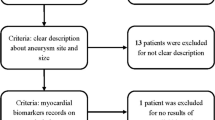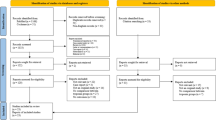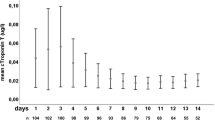Summary
A prospective single center study was performed to determine the minimal preoperative incidence of unrecognized cardiac injury in patients suffering aneurysmal and presumed aneurysmal subarachnoid hemorrhage (SAH). When caring for such patients in the pre- and post operative period clinicians must be aware of the possibility of cardiac injury even when a history of previous cardiac symptomatology is not present.
Forty-seven consecutive patients suffering from SAH over a five-month period underwent serum measurements of the cardiac muscle marker troponin I (cTnI) immediately upon admission. Repeat studies, if possible, were done 24 hours later. EKG was performed in all patients and was available for review in 44 of the 47 cases. Echocardiography was performed in four of eight patients with elevated cTnI levels. Signs and symptoms relating to cardiac ischemia were recorded by the patients' physicians and nurses.
Eight individuals (17%) had elevations in cardiac troponin I levels. Because surgical treatment is generally carried out as soon as possible following the hemorrhage, many patients with normal troponin I levels within twenty-four hours of their hemorrhage were operated upon before a repeat enzyme could be obtained or possibly before elevations could be recorded. In addition, a number of patients were referred to our center several days post-hemorrhage at a time when marker levels may have normalized. Therefore, the 17% incidence of elevated cTnI may be an underestimate. Only two of the eight patients had clinical abnormalities in cardiac function. Four patients with elevated levels had echocardiograms, three of which were abnormal. One additional patient died of a myocardial infarction before an echocardiogram could be obtained. EKG was abnormal in six of the seven patients with elevated troponin who had tracings available for review. Recordings consistent with recent myocardial ischemia were present in four of these. Of the 39 patients with negative troponin I levels, 37 had EKG available for review. None had recordings clearly consistent with recent myocardial ischemia although 13 were suggestive of ischemic changes. None of these 39 patients had pre- or post-operative clinical changes in cardiac function. Elevations in troponin I appeared to be unrelated to the patient's Hunt and Hess grade or Fisher score although our numbers were too small to draw any meaningful conclusions.
Similar content being viewed by others
Author information
Authors and Affiliations
Rights and permissions
About this article
Cite this article
Horowitz, M., Willet, D. & Keffer, J. The Use of Cardiac Troponin-I (cTnI) to Determine the Incidence of Myocardial Ischemia and Injury in Patients with Aneurysmal and Presumed Aneurysmal Subarachnoid Hemorrhage. Acta Neurochir (Wien) 140, 87–93 (1998). https://doi.org/10.1007/s007010050063
Issue Date:
DOI: https://doi.org/10.1007/s007010050063




